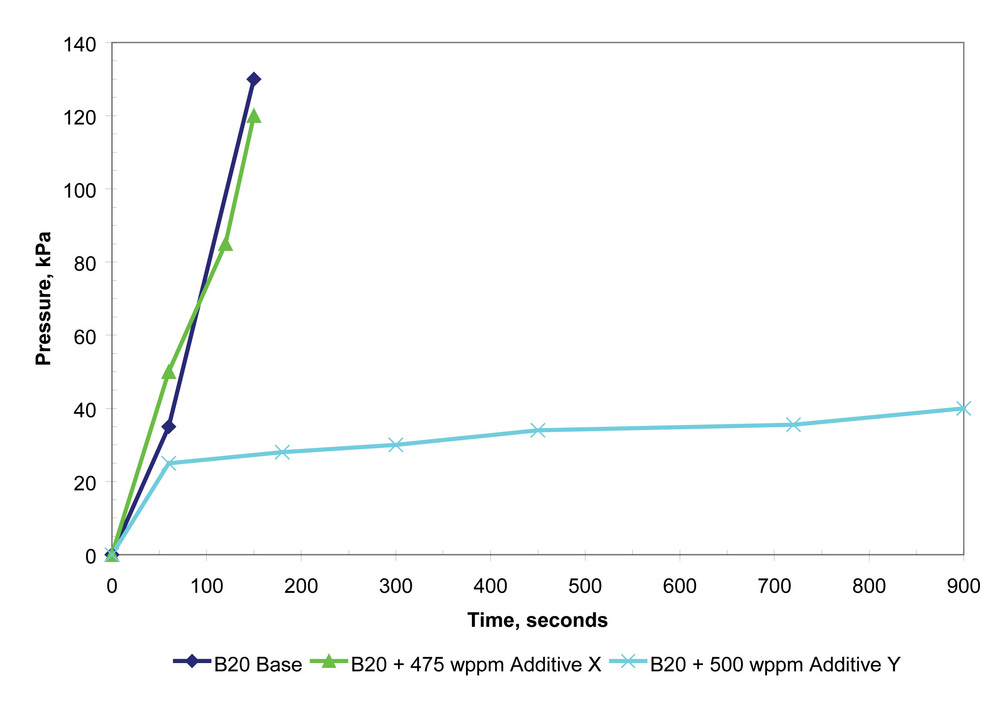Flowability: A Complex Issue



January 12, 2011
BY John Chandler Sr.
In today’s heavily regulated fuels environment, where fuels are subject to high quality standards, adverse impacts on the supply chain or on vehicle operability are not expected. But reports of blocked fuel dispensers and vehicle filters during biodiesel use have forced the industry to seek a solution as a matter of urgency. Petroleum additive companies such as Infineum are working to understand this complex issue, examining the role of additives in the elimination of these operability limitations.
The need to improve energy supply security, reduce greenhouse gas emissions and enhance air quality is accelerating the pace at which alternative fuels are being incorporated into automotive fuels. Fatty acid methyl ester (FAME) biodiesel has been used as a diesel fuel for more than 10 years. Now, in order to help meet legislated renewable volume targets, the use of biodiesel is increasing. However, the qualities and properties of the oils and fats used to make FAME vary significantly and ultimately affect the resulting fuel.
Vehicle and supply chain operability issues concerning the use of blends of diesel and biodiesel have been reported in recent years. These issues can be expensive for fuel suppliers to rectify, both in terms of actual cost and brand image. Reported field incidents involve the blocking of fuel dispensers and vehicle filters by materials that have precipitated out of biodiesel blends above the cloud point. Unfortunately, the way in which this occurs varies depending on the diesel and the type of biofuel used, the level of impurities and contaminants present in the fuel, the supply chain management and the climate, making the phenomenon difficult to study, hard to measure and tough to resolve.
A number of factors can contribute to poor filterability and operability, including water contamination, bacteria and fungi growth, presence of proteins, wax formation and settling, poor oxidation stability, and impurities such as monoglycerides and sterol glucosides. By examining a few of the main contributors, a much better understanding of the phenomenon can be gained.
Understanding the Causes
One of the biggest issues for FAME is its tendency to form wax crystals at low temperatures because of the degree of saturated fatty acids in the feedstock used to make the biodiesel. This wax can block vehicle filters and settle in storage and vehicle fuel tanks. As more highly saturated feedstocks are introduced, biodiesel and its blends with diesel are more likely to exhibit cold weather operability issues because of the additional saturated esters increases the total wax level in the fuels. Field issues observed in buses indicate that problems tend to occur on start-up in the morning in vehicles that have been refuelled the previous evening, suggesting that the wax had settled out in the fuel tank overnight. Unfortunately, the obvious solution on refuelling in the morning is not always practical as fleets often need to move off quickly at the start of the day. Appropriate additive solutions could help to provide consistent FAME product quality throughout the distribution system and ensure vehicle operability.
Advertisement
Microbiological issues can significantly affect pumping rates at service stations, increasing filling times and keeping vehicles off the roads for longer periods. Simple housekeeping measures, such as ensuring the tank levels do not fall too low and avoiding filling immediately after fuel delivery, can help to prevent the microbial material from being stirred up and drawn through the system. Treatment of bacteria or fungi with biocides can provide a remedial solution, as long as the tank is cleaned afterwards. Otherwise, as every subsequent delivery of fuel is treated, the dead bacteria build up in the tank, which can cause further filterability issues.
An issue that can arise when FAME is used as fuel in its neat form, B100, or in blends with diesel, is its tendency to oxidize during storage, transport and distribution. The oxidation products can lead to sediment formation, filter blocking, injector nozzle coking, and corrosion. The presence of metals, such as copper and iron, and impurities such as glycerol and free fatty acids, can make the situation even worse. Specifications have now been introduced around the world to set stability requirements in order to control FAME quality.
A wide range of impurities can also cause filtration issues in biodiesel. Monoglycerides, sterol glucosides, glycerin and soaps, which can be present in biodiesel, are undesirable in the resulting biodiesel blend with diesel. Upon cooling, the solubility of these impurities decreases, which means they can come out of solution as discreet crystalline particles. These particles can then go on to interact with other impurities and moisture, eventually forming structures that can interfere with the flow and filtration of the biodiesel blend above the cloud point.
Dispenser filter plugging issues at retail sites have been observed with B5 fuels at temperatures of around 5 degrees Fahrenheit (minus 15 degrees Celsius). These events were probably caused by polar compounds such as monoglycerides and other biodiesel contaminants, which have poor solubility in the fuel as it cools. The range of potential contaminants that could contribute to the formation of these precipitates, however, has yet to be fully defined and confirmed through testing.
Specifications and Tests
Advertisement
The ASTM D6751 specification covers biodiesel fuel blend stock, B100, in grades S15 and S500 for use as a blend component with middle distillate fuels. The standard sets limits for parameters including water, sediment, kinematic viscosity, sulphated ash, oxidation stability, sulphur, cetane number, cloud point, and total and free glycerin, among others. The Cold Soak Filtration Test, developed in response to low temperature vehicle filter blocking issues experienced in Minnesota, was added to the specification in 2008 to determine the suitability of B100 for biodiesel blends.
In Canada, the Canadian General Standards Board is working closely with the industry to develop two national standards to help ensure the quality of biofuels in its harsh climate: CGSB 3.520 for B1 to B5, and CGSB 3.522 for B6 to B20. They have also been looking at a more severe Cold Soak Filter Blocking Test.
Some additives that eliminate the visible cloud or haze that can form in biodiesel blends above the cloud point can still give poor filterability as demonstrated in the CSFT. This is because the small particles that block the 0.7 to 1.6 micron (μm) filters used in the test are not necessarily visible to the naked eye. These very small particles are a real concern to the industry because vehicle and dispenser filters are becoming less and less porous as the requirements for injector nozzles increase in severity.
Industry bodies have also been looking at introducing limits on certain impurities, with ASTM D6751 for example, limiting total glycerine in B100 to 0.24 percent. It is possible, however, that some B100 fuels that meet current limits may not be fit for purpose. To address this issue, ASTM formed the Filter Clogging Working Group, and its approach has been to propose limits on the amount of saturated monoglycerides. Setting limits on individual impurities in B100 will not guarantee that distribution systems and vehicles will be adequately protected, however, since, as already mentioned, filterability issues are not the result of one specific type of molecule. The development and introduction of a performance test would far better serve the industry and vehicle owners.
Collaboration is Essential
These many and varied issues will require careful consideration, and the industry has been very busy gathering data. Because so many factors can have an impact on the behavior of biodiesel blends in the field, Infineum has been actively working with diesel and biodiesel producers, fuel retailers, original equipment manufacturers and other industry players to gain a real insight into causes of these filterability and operability issues. This collaboration has resulted in the development of a test to assess the required level of filterability performance required to avoid field issues. By employing these new performance tests, Infineum has been able to develop robust, harms-free additive solutions to counter filterability issues. These advanced additives can enhance the quality of biodiesel blended fuels, helping suppliers to increase market share and improve margins.
A new video from Infineum is available, which highlights the problems associated with cold weather operation and the advantages of using cold flow additives. To view the video, visit http://www.infineum.com/Pages/ColdFlow.aspx.
Author: John Chandler Sr.
Fuel Additive Technologist, Infineum USA LP
(800) 654-1233
Upcoming Events





